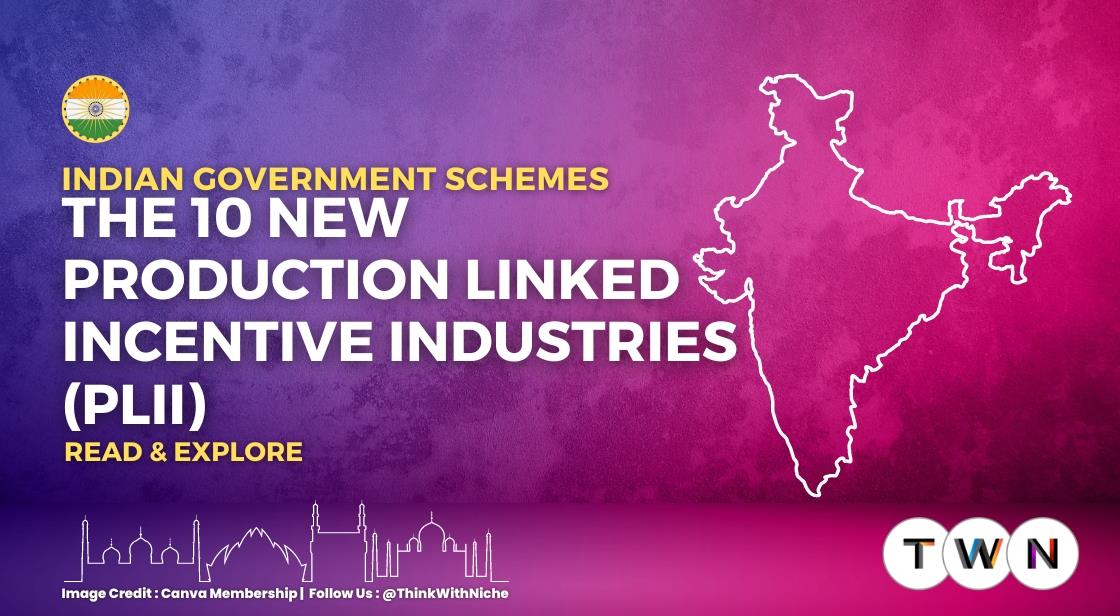Learn About The 10 New Production Linked Incentive Industries

Blog Post
To improve India's manufacturing capabilities and boost exports, the Indian government has expanded the Production-Linked Incentive (PLI) Scheme to 10 new industries with an extra financial investment of Rs. 1460 billion over a 5-year period. The advanced chemistry cell (ACC) battery, electronic/technology products, automobiles and auto parts, pharmaceuticals, telecom & networking products, textile products (man-made fibers and technical textiles), food products, high-efficiency solar PV modules, white goods (ACs & LED), and specialty steel are the new sectors that are included for the scheme.
For mobile manufacturing and electronic components, necessary raw materials (drug intermediaries and active pharmaceutical ingredients, or API), and medical devices, the PLI Scheme was initially introduced in April 2020. The introduction of the Production-Linked Incentive Scheme in the new 10 important sectors has now received approval from the Union Cabinet.
To establish national manufacturing champions, generate 60 lakh new jobs, and increase production by 30 lakh crore over the next five years, the honorable Finance Minister, Smt. Nirmala Sitharaman has announced an outlay of INR 1.97 lakh crores for the Production Linked Incentive (PLI) Schemes across 14 key sectors. The GoI also unveiled the following 10 new PLI schemes in November 2020, in addition to the three earlier announced in March 2020.
What does PLI Scheme mean? How come it was introduced?
Production-Linked Incentive, or PLI, is a program that attempts to incentivize companies for increased sales of goods produced domestically (over FY 2019–20). The initiative invites foreign businesses to open offices in India, but it also intends to incentivize domestic industries to open or expand their manufacturing facilities, create more jobs, and lessen India's dependency on imports from other nations.
Background of the PLI Scheme
The IT Ministry launched an initiative on April 1, 2020, that would offer incentives of 4-6% to electronics companies that produce mobile phones and other electronic components like transistors, diodes, thyristors, resistors, capacitors, and nano-electronic components like microelectromechanical systems. This scheme is a part of the National Policy on Electronics. The scheme offers incentives of up to 6% on additional sales of all such Indian-made mobile phones to manufacturers of mobile phones that sell for INR 15,000 or more.
Officials claim that the program will encourage domestic mobile phone manufacturers to increase the number of their manufacturing facilities and their presence in India while also bringing in foreign investment to the market. The PLI Scheme was formerly only available to certain industries, including those that manufacture medical devices, pharmaceutical ingredients, mobile phones, and related equipment.
The Indian government approved 53 bulk pharmaceuticals worth INR 6,940 crore (about USD 925 million) for PLI in March 2020. The program is anticipated to help up to 150 industrial facilities, resulting in additional sales of INR 46,400 crore (about USD 6187 million) and a sizable increase in employment over the course of the next eight years.
The PLI Scheme's stated goals were announced in March 2020.
The PLI Scheme was expanded to encompass more products for the following reasons:
To safeguard certain product areas
To enact non-tariff restrictions that raise the cost of imports.
Recognizing the importance of exports in the overall growth strategy while placing more emphasis on the home market
To stimulate both internal and external investment while promoting domestic manufacturing through production incentives.
What industries are now included in the PLI Scheme?
The scheme has been extended to eleven other industries, including food processing, telecom, electronics, textiles, specialty steel, automobiles and auto parts, solar photovoltaic modules, and white goods like air conditioners and LEDs.
Eligibility requirements for the PLI scheme
The PLI Scheme is open to businesses with Indian corporate registrations that manufacture goods that fall under the scheme's target market groups. Amounts of Incremental Investment (covered under Target Segments) over the designated base year must be met in order to qualify under the Scheme.
To be eligible for incentive disbursement for the year under consideration, an applicant must achieve threshold criterion (i.e., incremental investment) that is a minimum of INR 10 crore (MSME) or INR 100 crore (Others) and a maximum of INR 1000 crore. The total value of investments made up to that year, including the year under consideration, over the Base Year (2019–20), shall be taken into account in determining whether a given year meets the threshold requirements for incremental investment. There are threshold requirements for further sales in some industries.
The applicant may run an established or brand-new manufacturing facility at one or more sites across the nation.
Companies will be eligible for the incentive programme for any additional spending they make on plant, machinery, equipment, research and development, and the transfer of technology for manufacturing in the target segments.
With the help of the PLI scheme in these ten crucial niche markets, Indian manufacturers will become more competitive on a global scale, attract investment in cutting-edge technology and core competencies, ensure efficiency, foster economies of scale, boost exports, and establish India as a key player in the world supply chain.
Priority/s Sectors
1. Advance Chemistry Cell (ACC) Battery
2. Electronic/Technology Products
3. Automobiles & Auto Components
4. Pharmaceuticals drugs
5. Telecom & Networking Products
6. Textile Products: MMF segment and technical textiles
7. Food Products
8. High Efficiency Solar PV Modules
9. White Goods (ACs & LED)
10. Special Steel
1. Advance Chemistry Cell (ACC) Battery
The manufacturing of Advance Chemistry Cell (ACC) batteries is one of the biggest business possibilities of the twenty-first century for a number of emerging global industries, including consumer electronics, electric cars, and renewable energy. The PLI scheme for ACC battery will entice significant domestic and foreign businesses to set up a competitive battery manufacturing set-up in the nation with an incentive of Rs 181 billion.
2. Electronic/Technology Products
Electronic/Technology Products: The government's efforts to localize data, the Indian IoT market, and initiatives like Smart Cities and Digital India are also anticipated to boost demand for electronic goods. The PLI programme, which aims to increase the manufacture of electronic goods in India, will be applicable to items including servers, IoT gadgets, laptops, notebooks, and other computer hardware.
3. Automobiles & Auto Components
The Production-Linked Incentive (PLI) Scheme in the Automobile and Auto Components industries was launched by the Union Cabinet, which is presided over by Prime Minister Shri Narendra Modi. The PLI scheme (with a $3.5 billion budget) for the automotive industry suggests financial incentives of up to 18% to encourage domestic production of high-tech automotive products and draw capital to the industry's value chain. From April 1, 2022, for a period of five years, incentives are applicable for specific sales of goods made in India.The programme came to an end on January 9, 2022. Under this PLI scheme, 95 candidates in total have been approved: 20 under Champion OEM and 75 under Component champion.
4. Pharmaceuticals drugs
The pharmaceutical industry in India ranks 14th in terms of value and third in terms of volume worldwide. 3.5% of all drugs and medications exported internationally come from there. India has a strong ecosystem of related businesses and a complete ecology for the development and production of pharmaceuticals. The PLI plan will encourage domestic and international participants to engage in high value production.
5. Telecom & Networking Products
The introduction of the Production-Linked Incentive (PLI) Scheme in the Telecom & Networking Products sector for enhancing India's manufacturing capabilities and enhancing exports—Atmanirbhar Bharat—has been approved by the Union Cabinet, which is presided over by Prime Minister Shri Narendra Modi. 31 businesses, both domestic and international, received permission under the PLI Scheme in October 2021. Over the course of the PLI Scheme, these enterprises are anticipated to invest $450 million, create 40,000 jobs, and produce an additional $24.4 billion in revenue. In order to include Design-led Manufacturing Scheme as a component of the PLI Scheme with additional incentives totaling more than INR $533.33 million, the Department of Telecommunications (DoT) modified the PLI Scheme rules in June 2022.
India intends to become a significant original equipment manufacturer of telecom and networking goods. Telecom equipment is a crucial and vital component of developing a secure telecom infrastructure. The PLI programme is anticipated to draw sizable investments from major international players and assist domestic businesses in seizing new opportunities and dominating the export market. The PLI scheme is expected to generate Rs 2 lakh crore in production over the next five years and contribute to the creation of 1 lakh direct and indirect jobs in India, according to the Telecom Equipment Manufacturers Association of India (TEMA), which represents local telecom equipment manufacturers.
6. Textile Products: MMF segment and technical textiles
With an approved budget of INR 10,683 crore, the government has started the Production Linked Incentive (PLI) Scheme to encourage the manufacture of MMF apparel, MMF fabrics, and products of technical textiles in the nation and help the textile industry grow and become competitive. Applications for the PLI Scheme for Textiles were accepted online from January 1, 2022, until February 28, 2022. There have been 67 applications in all. 64 applications were chosen as part of the scheme by a selection committee led by the secretary (Textiles). 56 applicants have received clearance letters after meeting the prerequisites for the creation of a new firm. So far, investments of about INR 1536 crore have been invested. A Quality Control Order for VSF is currently being issued.
With a stake of roughly 5% in global textile and garment exports, India has one of the major textile industries in the world. However, compared to the overall world consumption pattern, which is mostly in this category, India's proportion in the manmade fibre (MMF) segment is small. With a budget of Rs. 106.83 billion, the PLI scheme is expected to draw significant investment, which would help to increase domestic manufacturing, particularly in the MMF category and technical textiles.
7. Food Products:
As the processed food sector expands, farmers receive greater prices and there is less waste overall. Products like ready to eat (RTE), ready to cook (RTC), marine products, fruits and vegetables, honey, desi ghee, mozzarella cheese, organic eggs, and poultry meat will be eligible for the scheme. Specific product lines with high growth potential and the ability to generate medium- to large-scale employment have been identified for support through PLI scheme.
8. High Efficiency Solar PV Modules
Given the electronic (hackable) structure of the value chain, large imports of solar PV panels present hazards to supply-chain resilience and present strategic security problems. The development of large-scale solar PV capacity in India will be encouraged by a targeted PLI programme for solar PV modules, enabling that country to gain an advantage in the global value chains for solar PV production.
9. White Goods (ACs & LED)
The Production Linked Incentive Scheme for White Goods (PLIWG) puts forth a financial incentive to promote domestic manufacturing and draw significant investments to the value chain of white goods manufacture. Its main goals include reducing sectoral barriers, generating economies of scale, boosting exports, building a strong component ecosystem, and creating jobs.
Air conditioners and LEDs are two examples of white goods that have a very high potential for domestic value addition and global competitiveness. A PLI programme for the industry would promote domestic manufacturing, job creation, and exports.
10. Speciality Steel
India is the world's second-largest producer of steel, which is a strategically significant industry. It has the potential to dominate some steel grades and is a net exporter of finished steel. A PLI programme for specialty steel will aid in improving steel with value added production capabilities, increasing overall exports.
With expenditures of Rs. 513.11 billion, the new programme will be an addition to the PLI schemes already announced for three industries: mobile manufacturing and specific electronic components, critical starting materials/drug intermediaries and active pharmaceutical ingredients, and manufacturing of medical devices (Rs 51311 crore).
The Union Government's Aatmanirbhar Bharat project, which aims to support an effective, equitable, and resilient manufacturing sector in the nation, includes the PLI Scheme.  Growth in industrial product production and exports will expose the Indian industry to a greater degree to foreign competition and ideas, which will enhance its capacity to develop further. In addition to facilitating integration with international supply chains, the promotion of the manufacturing sector and the development of a supportive manufacturing environment would also create backward links with the nation's MSME sector. The government news release claimed that it would result in significant employment prospects and economic growth overall.
Benefits: By implementing the PLI scheme across these 10 key targeted sectors, Indian manufacturers will become more competitive on a global scale, attract investment in cutting-edge technology and core competencies, ensure efficiency, foster economies of scale, boost exports, and establish India as a crucial link in the global supply chain.
Promoting the digital economy
By 2025, India is anticipated to develop a digital economy worth USD 1 trillion. The government's efforts to promote data localisation, the Internet of Things, and initiatives like Smart Cities and Digital India are also anticipated to boost demand for electronic goods.
Boost exports:
The pharmaceutical industry in India ranks 14th in terms of value and third in terms of volume worldwide. 3.5% of all medications and medicines exported internationally come from it.
India is the second-largest producer of steel worldwide. It exports finished steel on a net basis. A PLI programme for specialty steel will aid in improving steel with value-added production capabilities, increasing overall exports.
In order to attain diverse qualities, including heat resistance, hardness, and corrosion resistance, specialty steel is created by adding various elements to iron.
Way ahead
The Indian industrial sector would be exposed to more global competition and ideas as output and exports of industrial goods increase, which will enhance its capacity to innovate further.
In addition to facilitating integration with international supply chains, the promotion of the manufacturing sector and the development of a supportive manufacturing environment would also create backward links with the nation's MSME sector.
It will result in economic expansion overall and vastly increase the number of job possibilities.
You May Like
EDITOR’S CHOICE












